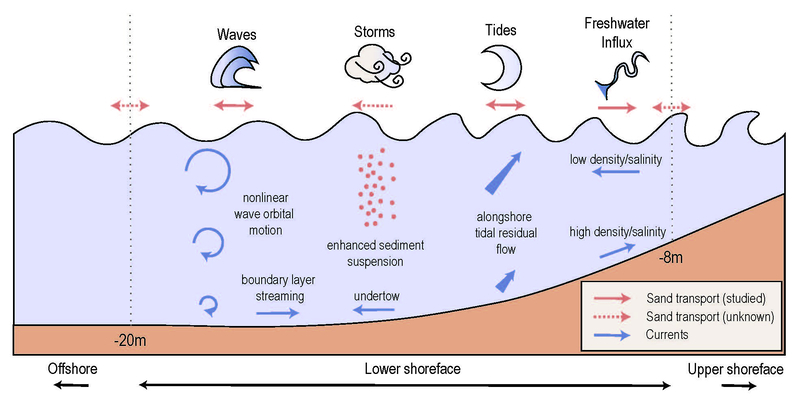P.F.V.W. Frankemölle1*, J.J. van der Werf1,2, R.W.M.R.J.B. Ranasinghe1,2,3, S.J.M.H. Hulscher1
1 University of Twente; 2 Deltares; 3 IHE Delft
*corresponding author:
Introduction
The Dutch lower shoreface is a sandy and gently sloping (1:200 to 1:1000) environment that separates the upper shoreface and the continental shelf, situated between the depths of -8m and -20m. Sand transport rates in the lower shoreface are relatively small, complex and determined by nonlinear processes. It is assumed that waves and storm events play a large role in the morphological evolution of the lower shoreface (van der Spek et al., 2022, and references therein), though the effects of storm events on lower shoreface sand transport have not been studied in depth. Most knowledge on lower shoreface sand transport stems from modelling efforts, where calculated cross-shore sand transport rates are unreliable, to the extent where it is unknown if the transport is directed offshore or onshore. This transport might impact the long term evolution of the coastal foundation and consequently may be important for coastal protection, which becomes increasingly relevant with the continuous threat of increased sea level rise.
Aim & Approach
This PhD research aims to identify and quantify dominant sand transport processes (e.g., waves, winds, density-driven currents) in the lower shoreface, with a specific interest in the effects of storm events. We will investigate the importance of these processes on shorter timescales and their influence on net sediment transport over longer (morphological) timescales. This will be done with a combination of 2DV and 3D hydrodynamic simulations of the Dutch Coast in Delft3D-FM, coupled with sediment transport equations. The research is part of the recently started MELODY (ModEling LOwer Shoreface Seabed DYnamics for a Climate-Proof Coast) project, that has the goal to improve the understanding of lower shoreface seabed dynamics and is funded by the NWO.

Figure 1: Schematic cross-shore overview of the lower shoreface showing different physical processes with associated net sediment transport direction. In general, these processes are stronger closer onshore.
References
van der Spek, A., van der Werf, J., Oost, A., Vermaas, T., Grasmeijer, B., & Schrijvershof, R. (2022). The lower shoreface of the Dutch coast – an overview. Ocean & Coastal Management, 230, 106367. https://doi.org/10.1016/j.ocecoaman.2022.106367
I. Surname1*, F.N. Another-Surname2 , Y. Next-Surname2
1 University Name, Country; 2 Organization Name, Country
* Corresponding author: mail.name@organization.org


